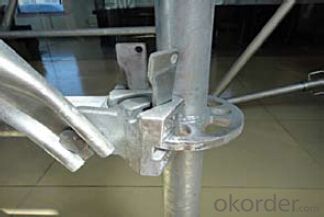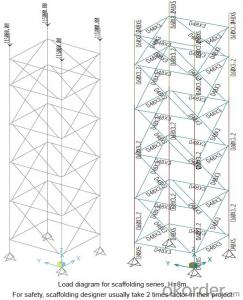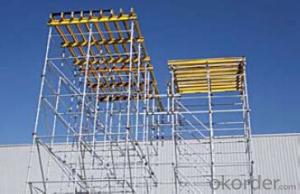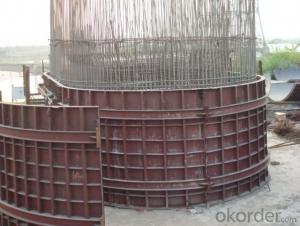Ring-lock scaffolding accessories for Formwork and Scaffolding System
- Loading Port:
- Tianjin
- Payment Terms:
- TT OR LC
- Min Order Qty:
- 50 m²
- Supply Capability:
- 1000 m²/month
OKorder Service Pledge
Quality Product, Order Online Tracking, Timely Delivery
OKorder Financial Service
Credit Rating, Credit Services, Credit Purchasing
You Might Also Like
Ring-lock Scaffolding
A support system for construction, ownsadvantages of both cup-lock scaffolding andshoring tower.
It is in the development direction of new typescaffolding.
It is widely used in buildings, bridges, tunnels etc..
Characteristics:
◆ Easy to storage and transportation
◆ High degree of standardization
◆ Easy and quick erection
◆ Excellent stability and bearing capacity
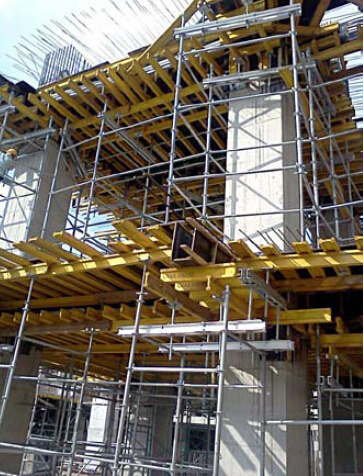
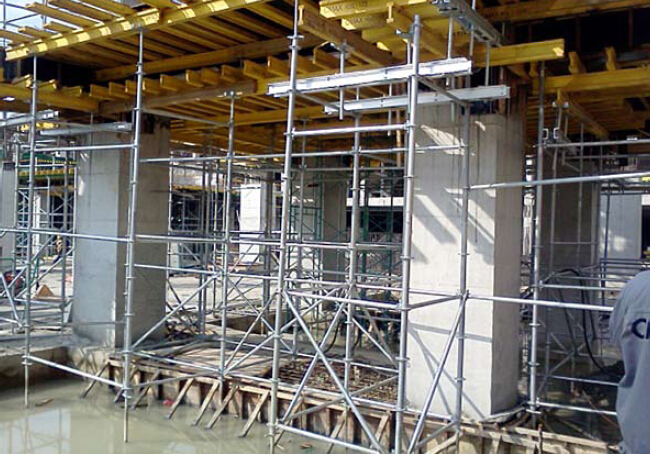
- Q: What are the different types of formwork clamps used in steel formwork?
- In steel formwork construction, various types of formwork clamps are commonly utilized. Their purpose is to ensure the firm connection of formwork panels, thereby guaranteeing stability and accuracy during the concrete pouring process. 1. Wedge Clamps: Among the most frequently employed formwork clamps are wedge clamps. These clamps consist of wedge-shaped pieces that are inserted into slots on the formwork panels. As the wedges are driven further into the slots, a tight and secure connection is established between the panels. 2. Rapid Clamps: Rapid clamps are designed for swift and effortless installation and removal. Equipped with a spring-loaded mechanism, these clamps enable easy tightening or loosening with minimal exertion. 3. Turnbuckle Clamps: Adjustable clamps known as turnbuckle clamps provide additional tension and support to the formwork panels. Comprising a threaded rod with a turnbuckle mechanism, these clamps can be tightened or loosened to adjust the tension on the formwork. 4. Pipe Clamps: Pipe clamps employ pipes or tubes to connect and secure the formwork panels. Typically, they consist of U-shaped brackets attached to the formwork panels and pipes or tubes inserted into the brackets to hold the panels together. 5. Panel Clamps: Panel clamps are specially designed to hold large formwork panels together. These clamps usually feature a large, heavy-duty mechanism that can be tightened or loosened to securely hold the panels in place. Each type of formwork clamp possesses its own unique characteristics and advantages. The selection of the appropriate clamp depends on factors such as the size and weight of the formwork panels, the desired level of stability, and the specific requirements of the construction project.
- Q: What are the different types of finishes available for steel formwork?
- Steel formwork offers a variety of finishes, each with its own advantages and characteristics. Here are some commonly used finishes: 1. Smooth finish: This is the most basic option, leaving the steel formwork untreated. It creates a clean and smooth surface, perfect for achieving a polished concrete finish. 2. Galvanized finish: To protect against corrosion, the steel formwork is coated with a layer of zinc. This durable finish can withstand harsh weather conditions, so it is ideal for outdoor applications. 3. Powder-coated finish: A dry powder is applied to the steel formwork and then baked on, resulting in a decorative and long-lasting coating. It is resistant to chipping, scratching, and fading, and offers a wide range of colors for customization. 4. Painted finish: Another common choice is to paint the steel formwork. This not only enhances its aesthetics but also provides protection against corrosion. The type of paint used can vary based on project requirements, such as epoxy or acrylic paints. 5. Shot-blasted finish: By projecting small steel shots at high velocity onto the formwork surface, shot blasting removes impurities, rust, or old coatings, creating a clean and textured finish. This type of finish is often desired for better concrete adhesion. 6. Treated finish: Some steel formwork can be treated with special coatings or chemicals to enhance its properties. For instance, anti-stick coatings prevent concrete from sticking to the formwork, making it easier to remove after curing. Other treatments may include rust inhibitors or fire-resistant coatings. When choosing a finish for steel formwork, factors such as intended use, environmental conditions, desired aesthetics, and budget should be considered. Consulting a professional or manufacturer can help determine the most suitable finish for a specific project.
- Q: Can steel formwork be used for architectural construction projects?
- Indeed, architectural construction projects can utilize steel formwork. This versatile and durable construction material is commonly employed in architectural projects due to its numerous advantages. Steel formwork provides high strength, stability, and reusability. It can withstand high pressure and deliver a smooth and precise finish to concrete structures. Moreover, it is resistant to warping, bending, and shrinking, guaranteeing the structural integrity of the construction. Steel formwork is highly customizable, accommodating any shape or size, thus enabling architects to design unique and intricate structures. Thanks to its strength and durability, steel formwork can be reused multiple times, making it a cost-effective choice for construction projects. All in all, steel formwork is a dependable and efficient option for architectural construction endeavors.
- Q: What are the considerations when designing steel formwork for underground parking structures?
- When designing steel formwork for underground parking structures, several key considerations should be taken into account. Firstly, the formwork must be able to withstand the heavy loads and pressures exerted by the surrounding soil and any potential water infiltration. It is crucial to ensure the strength, stability, and durability of the formwork system to prevent any structural failures or collapses. Additionally, careful attention should be paid to the formwork's waterproofing capabilities. Adequate waterproofing measures, such as the use of sealants or membranes, must be incorporated to protect the structure against potential water ingress, which could lead to corrosion and long-term damage. Moreover, the design should allow for efficient and safe construction. This includes considering factors such as ease of assembly and disassembly, ensuring proper access and working space for construction workers, and incorporating appropriate safety measures to prevent accidents during the formwork installation and removal processes. Lastly, the formwork design should also take into consideration the desired architectural and aesthetic elements of the parking structure. This may involve incorporating specific finishes, textures, or patterns on the exposed concrete surfaces, which can enhance the overall visual appeal of the underground parking facility. Overall, the considerations when designing steel formwork for underground parking structures revolve around ensuring structural integrity, waterproofing capabilities, construction efficiency, safety, and meeting the desired architectural requirements.
- Q: Can steel formwork be used for both indoor and outdoor construction projects?
- Yes, steel formwork can be used for both indoor and outdoor construction projects. Steel is a durable and versatile material that can withstand different weather conditions, making it suitable for various construction environments.
- Q: What are the different sizes and dimensions of steel formwork?
- Different construction requirements and project needs can be catered to by steel formwork, which is available in various sizes and dimensions. The typical sizes of steel formwork panels are 2 meters (6.5 feet) in height and 1 meter (3.2 feet) in width, although these measurements can differ depending on the manufacturer and specific project requirements. The thickness of steel formwork panels is usually between 12 to 14 millimeters (0.5 to 0.6 inches) to ensure they are strong enough to withstand the pressure exerted by the concrete during pouring and curing. Furthermore, steel formwork panels can be obtained in different lengths to accommodate varying wall heights and dimensions, ranging from 1 meter (3.2 feet) to 4 meters (13.1 feet) or even longer, depending on project specifications. In addition to panels, steel formwork systems consist of other components like beams, props, adjustable struts, and connectors. These components are available in different sizes and dimensions to provide support for the formwork structure and ensure stability and safety throughout the construction process. It is essential to keep in mind that the sizes and dimensions of steel formwork can vary based on the manufacturer, project specifications, and regional construction practices. Therefore, consulting with the manufacturer or a structural engineer is crucial to determine the appropriate sizes and dimensions of steel formwork required for a specific construction project.
- Q: Can steel formwork be used for curved walls?
- Yes, steel formwork can be used for curved walls. Steel formwork offers flexibility and strength, making it suitable for creating curved shapes. The steel panels can be easily bent and shaped to match the desired curvature of the wall. Additionally, steel formwork provides excellent support for concrete, ensuring that the curved wall maintains its shape during the pouring and curing process. It is worth noting that specialized skills and expertise may be required to properly design and construct curved walls using steel formwork.
- Q: What are the different types of release agents used with steel formwork?
- There are several different types of release agents that can be used with steel formwork. Some of the most common types include: 1. Water-based release agents: These types of release agents are composed primarily of water, with additives such as surfactants and lubricants. They are environmentally friendly and easy to apply, typically by spraying or brushing onto the steel formwork. Water-based release agents form a thin film on the surface of the steel, preventing adhesion of the concrete during the curing process. 2. Solvent-based release agents: Solvent-based release agents use organic solvents as the carrier for the active ingredients. They are effective in providing a smooth surface finish on the concrete and are often used in situations where a higher level of release performance is required. Solvent-based release agents are typically applied by spraying or brushing and evaporate quickly, leaving a thin film on the steel formwork. 3. Barrier release agents: Barrier release agents are typically applied as a thick paste or gel and provide a physical barrier between the steel formwork and the concrete. They are often used in situations where a high-quality surface finish is required, such as architectural concrete applications. Barrier release agents can be applied by brushing or troweling onto the steel formwork. 4. Dry release agents: Dry release agents are powdered or granular materials that are applied directly to the steel formwork. They create a non-stick surface by absorbing excess moisture from the concrete, preventing adhesion. Dry release agents are commonly used in situations where other types of release agents may not be suitable, such as in cold weather conditions. 5. Form release oils: Form release oils are petroleum-based products that are commonly used with steel formwork. They provide an effective release barrier between the steel and the concrete, preventing adhesion. Form release oils are typically applied by spraying or brushing onto the steel formwork and can be used in a variety of concrete applications. It is important to select the appropriate type of release agent based on the specific requirements of the project, including the desired surface finish, environmental considerations, and ease of application. Consulting with a professional or manufacturer's recommendations can help determine the most suitable release agent for a particular steel formwork application.
- Q: What are the typical maintenance requirements for steel formwork systems?
- The maintenance needs of steel formwork systems can differ based on their specific design and usage. However, there are several routine maintenance tasks that need to be carried out to guarantee optimal performance and durability. To begin with, it is crucial to thoroughly clean the steel formwork after each use in order to eliminate any concrete residue or debris. This can be accomplished by using water and a brush or high-pressure cleaning equipment. It is important to completely remove all traces of concrete to prevent buildup and potential harm to the steel. Furthermore, it is vital to inspect the formwork regularly to identify any signs of wear or damage. Regular inspections can help detect any problems early on and prevent them from escalating into more significant issues. This includes checking for cracks, dents, or bent components that may compromise the formwork's integrity or affect its alignment. In addition, it is necessary to lubricate the movable parts to ensure smooth operation. Steel formwork systems often have adjustable components such as clamps, connectors, or locking mechanisms that may require lubrication to reduce friction and facilitate easy adjustments. Applying an appropriate lubricant to these parts will help maintain their functionality and prevent them from becoming stuck or difficult to operate. Moreover, proper storage of the steel formwork when not in use is important. This typically involves storing the components in a dry and well-ventilated area to prevent corrosion. Moisture can cause rust and deterioration of the steel, so it is crucial to keep the formwork away from areas with high humidity or direct water exposure. Lastly, regular maintenance should include periodic reconditioning or repair of any damaged or worn-out parts. This may involve replacing worn-out components, reinforcing weak areas, or welding any cracks or fractures. Performing these repairs promptly helps maintain the structural integrity of the formwork and ensures its safe and reliable operation during subsequent uses. Overall, by adhering to these routine maintenance requirements such as cleaning, inspection, lubrication, proper storage, and timely repairs, the steel formwork systems can be kept in excellent condition, prolonging their lifespan and guaranteeing their performance and safety in construction projects.
- Q: Can steel formwork be used for both cast-in-place and precast concrete structures?
- Yes, steel formwork can be used for both cast-in-place and precast concrete structures. Steel formwork is versatile and can be easily adjusted and reused for different projects, making it suitable for both construction methods.
Send your message to us
Ring-lock scaffolding accessories for Formwork and Scaffolding System
- Loading Port:
- Tianjin
- Payment Terms:
- TT OR LC
- Min Order Qty:
- 50 m²
- Supply Capability:
- 1000 m²/month
OKorder Service Pledge
Quality Product, Order Online Tracking, Timely Delivery
OKorder Financial Service
Credit Rating, Credit Services, Credit Purchasing
Similar products
Hot products
Hot Searches
Related keywords



